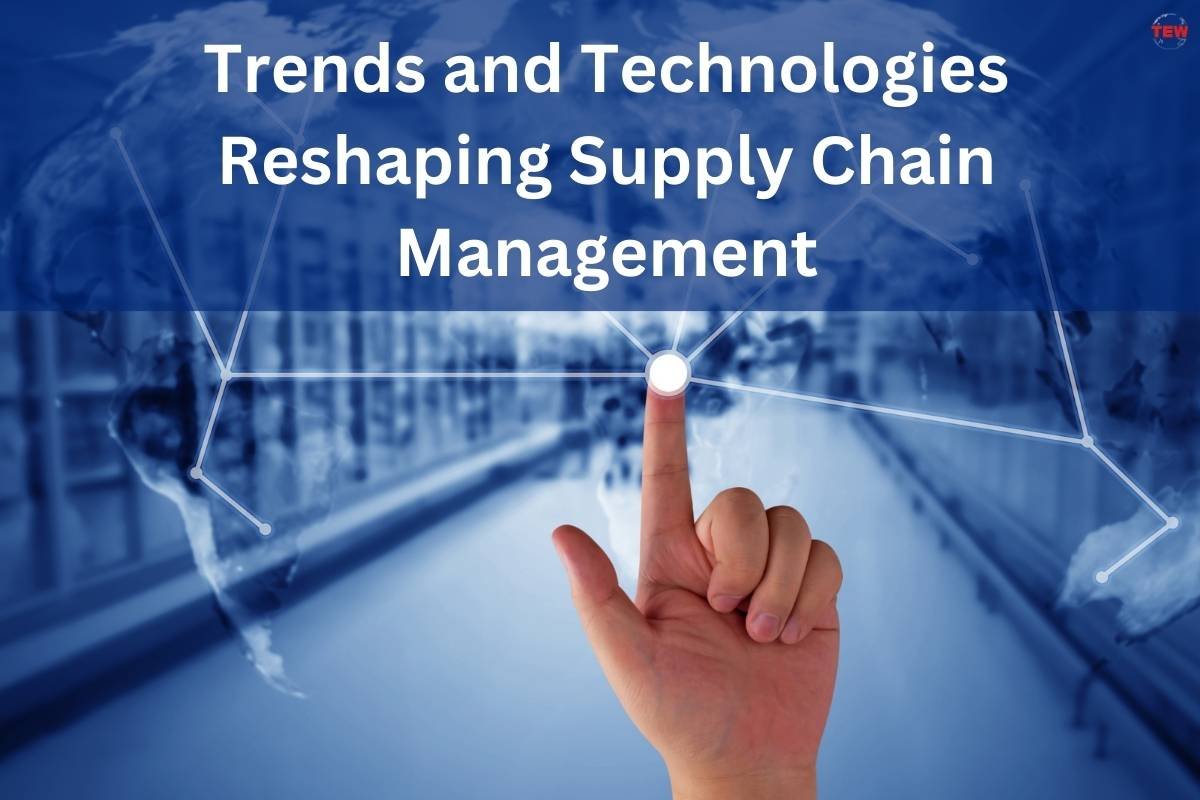A major shift is now taking place in the logistics and supply chain sector, which is occasionally seen as the foundation of global trade. As the globe gets more connected and consumer expectations rise, the challenges this industry faces have grown in quantity and complexity.
Logistics is not just about moving goods from point A to point B anymore. It’s about making sure that goods move faster, more efficiently, and with complete transparency. All while minimizing costs and environmental impact.
This article will guide you through this transformative journey, shedding light on the nine major trends and technological developments that are setting the course for the future of supply chain management.
Here are 9 major trends and technological developments for the future of supply chain management:
1. Supply Chain Agility
Digital advancements are rapidly changing the way business is done, so the agility of supply chains has become critical The essence of this agility lies in the ability of businesses to swiftly adapt to the market dynamics.
One of the key components driving this agility is the concept of self-managed onboarding, change, and exception management. Adopting self-managed services enables businesses to directly manage their operations.

By doing so, they will be less dependent on outside businesses and will be able to react quickly to developments. In essence, a nimble supply chain management is a competitive advantage.
2. Artificial and Augmented Intelligence
The logistics sector is at the forefront of integrating Artificial Intelligence (AI) into its operations. From intelligent transportation systems to advanced route planning and demand forecasting, AI is playing a major role in streamlining logistics processes.
According to a report by McKinsey, AI-driven supply chain improvements could lead to a potential 50% reduction in lost sales, along with a 65% decrease in inventory costs. This showcases the immense potential AI holds in optimizing supply chain operations.
The emergence of augmented intelligence, which combines human intelligence with AI, further enhances the capabilities of AI. A study by Gartner predicts that by 2025, Augmented Intelligence could boost business value by over $2.9 trillion and recover 6.2 billion hours of worker productivity.
This synergy ensures that while AI handles repetitive and data-intensive tasks, invaluable human insights are not lost. The result is a more efficient logistics operation that leverages the best of both worlds.
3. Real-Time Supply Chain Visibility
With the abundance of smartphones and instant access to information, modern consumers are no longer content with just placing an order. They want to know the status of their order at every stage. This thirst for real-time information has catalyzed the transformation of Supply Chain Visibility (SCV) from a mere operational tool to a real-time tracking system.
The demand for transparency and real-time updates is not just a consumer-driven phenomenon. Businesses too, in their quest for operational efficiency, are recognizing the value of real-time insights. A clear example of this change is the use of real-time data in integrated supply chains.
The Internet of Things (IoT) is an important factor in this revolution. With billions of connected devices worldwide, IoT offers an unparalleled opportunity for supply chains to monitor and track assets.
From temperature-sensitive shipments being monitored through IoT-enabled sensors to ensure product integrity to geo-fencing technologies that provide instant alerts if a shipment deviates from its route, the possibilities are endless.
4. Digital Twins
The digital twin technology, a convergence of the physical and digital worlds, is making waves in the logistics sector. A digital twin is a dynamic, virtual representation of a physical object or system.
Real-time data, simulations, and cutting-edge analytics are used to enhance comprehension, learning, and reasoning. This approach seeks to connect the physical and digital worlds instead of just creating a digital duplicate.
In the context of logistics, the implications of digital twins are vast. For instance, imagine a sprawling logistics center with intricate warehousing systems, transportation nodes, and inventory management protocols.
Any change in layout or equipment can have cascading effects on efficiency, cost, and service levels. Traditionally, experimenting with such changes would be time-consuming, expensive, and would carry certain risks.
With digital twin technology, businesses can create an accurate 3D model of their logistics center. This isn’t just a static representation but a dynamic model that can simulate various scenarios.
Want to see how a new conveyor belt system would impact the flow of goods? Or how a change in storage layout might optimize space? With digital twins, these scenarios can be played out in the digital realm, providing invaluable insights without any real-world consequences.
5. Blockchain
Blockchain is the technology behind cryptocurrencies like Bitcoin, and it is steadily gaining traction in various industries, and logistics is no exception.
Blockchain is a decentralized ledger of all network transactions. This ensures openness and trust among all parties involved since once a transaction is uploaded to the blockchain, it becomes permanent and is visible to everyone in the network.
Transparency, trust, and traceability are critical in the logistics sector. Given the multitude of stakeholders involved—from manufacturers to shippers, carriers, and end consumers – the need for a single source of truth becomes clear. Blockchain addresses this need head-on.

The seamless sharing of data across many stakeholders is one of the biggest issues in logistics. Traditional systems often operate in silos, which causes delays, poor communication, and higher expenses. Due to its decentralized structure, blockchain enables real-time data sharing, guaranteeing that all participants are in agreement.
For instance, a package traveling from a manufacturer in China to a store in the US encounters numerous touchpoints along the way, including ports, customs, carriers, and more. With blockchain, every stage of this process can be documented and independently validated by all participants, ensuring transparency and reducing the likelihood of disagreements.
6. Data Standards and Advanced Analytics
It’s common to refer to data as the “new oil.” However, the sheer amount and diversity of data can be intimidating for many companies, particularly in logistics.
The logistics sector, with its nearly countless stakeholders, touchpoints, and processes, often grapples with fragmented and siloed data. This fragmentation has historically led to inefficiencies, miscommunication, and missed opportunities.
Recognizing the critical importance of cohesive and standardized data, industry bodies and organizations are stepping up their efforts. A prime example is the Digital Container Shipping Association (DCSA), which is working diligently to establish common IT standards across the logistics sector.
This standardization strives to make data easily integrated, analyzed, and used throughout the whole supply chain, independent of its source or format. Operations are streamlined as a result, and stakeholders are encouraged to work together and be transparent.
But data standardization is just one piece of the puzzle. The real value of data lies in its analysis and interpretation. Enter advanced analytics. With the advent of powerful computational tools and algorithms, businesses can now delve deep into their data, extracting previously elusive insights.
Predictive analytics, in particular, is proving to be a game-changer. By analyzing historical data, predictive analytics can forecast future trends, allowing businesses to be proactive rather than reactive. For instance, by analyzing shipment data, companies can predict potential delays and take preemptive measures, ensuring timely deliveries and enhanced customer satisfaction.
7. Global Labor Shortages and Automation
Like many other industries worldwide, the logistics business is struggling with a serious problem: a lack of qualified workers. This shortage is a structural problem rather than simply a temporary one, made worse by things like an aging workforce, shifting demographics, and changing job requirements.
In response to this crisis, the industry is turning to technology, specifically automation, as a solution. Automation, in this context, doesn’t merely represent a technological upgrade but a fundamental reimagining of logistics operations.
Warehousing, a critical component of the logistics value chain, is at the forefront of this automation drive. Whether it’s a vertical storage system or some other advanced robotics system – they are now being deployed for tasks that were traditionally manual.
For instance, robots equipped with AI and machine vision can pick products from shelves, pack them, and even restock items, operating around the clock without fatigue. Companies like Amazon have already integrated thousands of robots into their fulfillment centers, increasing efficiency and reducing operational costs.
8. Ecosystem Integration Implementation
The logistics industry, historically characterized by its complex operations and many stakeholders, is undergoing a transformative phase. There’s a pressing need for the logistics sector to evolve, ensuring that its systems and processes are integrated, efficient, and responsive to the dynamic market demands.
One of the most significant shifts in this direction is the move toward ecosystem integration. This essentially means creating a cohesive environment where various components of the logistics value chain – from suppliers and carriers to end consumers – are seamlessly connected, allowing for real-time communication, data sharing, and collaborative decision-making.
A cornerstone of this integration drive is the adoption of API (Application Programming Interface) based integrations. APIs act as bridges between disparate systems, enabling them to communicate and share data without extensive customization. For the logistics sector, this means that a shipper’s system can instantly connect with a carrier’s system, fetching real-time data on shipment status, pricing, or capacity availability.
Another trend reshaping the logistics landscape is the rise of digital freight marketplaces. These platforms, often likened to the ‘Uber for trucking,’ connect shippers with carriers, bypassing traditional intermediaries. The result is a more transparent, efficient, and cost-effective logistics process.
9. The Growing Importance of Industry Newcomers
Traditionally dominated by established players with vast infrastructures and legacy systems, the logistics sector is experiencing a seismic shift. This transformation is being brought about by a wave of newcomers to the business, especially startups, who are using technology, creativity, and new viewpoints to question and redefine industry norms.
One of the defining characteristics of these newcomers is their “asset-light” approach. Unlike traditional logistics companies, which often own fleets of trucks, warehouses, and other physical assets, these startups operate with minimal physical assets.

Instead, they rely on digital platforms, data analytics, and partnerships to deliver value. This model offers them unparalleled agility, allowing them to quickly adapt to market changes, scale operations, and reduce overhead costs.
Wrapping Up:
Technology improvements will undoubtedly impact supply chain management in the future. Businesses must proactively adopt these trends to stay ahead of the curve as the market progresses.
From integrating AI and Augmented Intelligence to adopting blockchain and digital twins, the logistics sector is all set for a transformative journey.
Moreover, the rise of startups and industry newcomers is a testament to the dynamic nature of the logistics world. Their innovative approaches and solutions challenge traditional business models and drive the entire industry towards greater transparency, efficiency, and customer-centricity.




